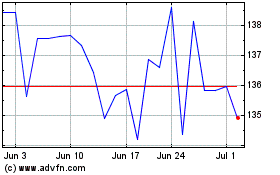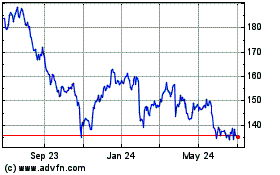Amazon Prods Its Sellers to Free Up Warehouse Space
November 04 2016 - 10:40AM
Dow Jones News
Amazon.com Inc. has a holiday message for the millions of
merchants who rely on it to fill their online orders: Don't clutter
its warehouses with stuffed Easter bunnies, Fourth of July banners
or other out-of-season goods.
Though the big online retailer has built more than two dozen new
warehouses this year, increasing its square footage by 30%, it says
it needs all the space it can get to cope with the annual boom in
holiday orders. That is why it is trying to discourage its
third-party sellers from stocking up on items that aren't likely to
sell by the end of the year.
"We're trying to incentivize sellers to wait to send us the
Easter-themed cookie cutter sets," said Cynthia Williams, vice
president of Fulfillment by Amazon, the service that stores
sellers' products and ships their orders to customers. Last year,
600 such sets arrived in the fourth quarter.
Hoping to avoid similar incidents this year, Amazon, for the
first time, is charging its sellers a premium for storing
merchandise in its warehouses during November and December. It is
partly offsetting that increase by lowering its fees for fulfilling
orders, another way to encourage sellers to avoid items likely to
linger on its shelves.
Amazon executives say that its warehouses overflow with
third-party sellers' goods, especially as Christmas nears,
straining its capacity and increasing costs. In recent weeks, the
company has temporarily stopped accepting shipments from new
sellers. Established sellers are required to time their shipments
to arrive by Nov. 9 to guarantee they will be available for the
crucial post-Thanksgiving shopping weekend and by Dec. 2 to be
available in time for Christmas. For the third time this year,
Amazon also offered to remove sellers' goods from its warehouses
free of charge for disposal or return.
The idea is to speed the flow of goods and optimize use of
space, Amazon's chief financial officer, Brian Olsavsky, said last
month on an earnings conference call.
Brad King, whose online apparel retailer Webzom sells via
Amazon, said his costs for using Fulfillment by Amazon might rise
30% over the holidays, based on preliminary calculations. In
response, he said, he is making more frequent but smaller shipments
to Amazon of the about 6,000 products he sells through that
service, instead of the large shipments he previously made every 90
days. "We're trying to be more efficient in what we're sending," he
said.
Amazon says about a quarter of the merchandise sold on its site
are part of its fulfillment program, which charges storage fees
based on volume. Starting this month, storage fees for
standard-size items are due to more than triple to $2.25 per cubic
foot a month, up from 54 cents the rest of the year.
A seller with 500 small Easter baskets in stock, for example,
would pay storage fees of about $124 in November, up from $30 a
month the rest of the year. At the same time, Amazon is lowering
the cost of fulfilling those items by 5% to $2.88 per unit, to help
offset some of the storage increase.
Amazon said it makes considerably more when its fulfillment
customers make a sale than when their goods languish, racking up
storage charges.
"The more the inventory turns, the more fees they drive,"
generating revenue, said John Haber, chief executive of
supply-chain consulting firm Spend Management Experts.
Most sellers will likely struggle to fully understand the impact
to their bottom line until after the holidays, said Eric Heller,
chief executive of seller and brand-strategy consulting firm
Marketplace Ignition. "There's so many moving parts," he said.
"It's going to take sellers a month or two of evaluating their
sales to understand."
The temporary increase in storage fees marks one of Amazon's
first experiments with surge pricing—charging more for goods or
resources when demand is highest. Other companies, including
package-delivery giant United Parcel Service Inc. have introduced
some peak surcharges. UPS's is to encourage shippers to make more
accurate predictions of their package volume.
Jordan Malik, who sells everything from shampoo to used books on
Amazon, said that the prices consumers pay on Amazon's site
typically get a lift during the holidays, something that will help
offset fulfillment price increases. Amazon typically takes about a
30% cut of his merchandise for storing, selling and shipping it
when a customer clicks "buy."
"The people who grumble about the fee increases tend to be the
sellers who kind of are ruining it for everyone else," he adds,
including those leaving merchandise that won't sell sitting in
Amazon's warehouses.
Still, even when the fees rise, most sellers will stay, he says.
"Amazon is the big dog."
Write to Laura Stevens at laura.stevens@wsj.com
(END) Dow Jones Newswires
November 04, 2016 10:25 ET (14:25 GMT)
Copyright (c) 2016 Dow Jones & Company, Inc.
United Parcel Service (NYSE:UPS)
Historical Stock Chart
From Mar 2024 to Apr 2024

United Parcel Service (NYSE:UPS)
Historical Stock Chart
From Apr 2023 to Apr 2024
